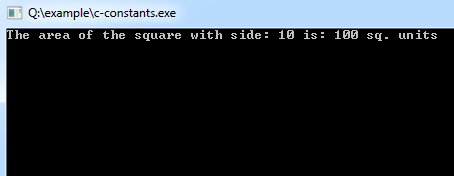Declaration & Assignments
Constants are like variable, except that their value never changes during execution once defined.

C Constants
Constants are like variable, except that their value never changes during execution once defined.
C Constants is a most basic and important part of C programming language. Constants in C are the fixed values that are used in a program, and its value remains the same during the entire execution of the program.
Constant Definition in C
Syntax:
const type constant_name;const keyword defines a constant in C.
Example:
#include<stdio.h>
main()
{
const int SIDE = 10;
int area;
area = SIDE*SIDE;
printf("The area of the square with side: %d is: %d sq. units"
, SIDE, area);
}Run Program Output:

It is possible to put const either before or after the type.
int const SIDE = 10;or
const int SIDE = 10;Constant Types in C
Constants is categorized into two basic types and each of these types has own sub types/categories. These are:
Primary Constants
Integer Constant
Its refer to sequence of digits. Integers are of three types viz:
Example:
15, -265, 0, 99818, +25, 045, 0X6
Real constant
The numbers containing fractional parts like 99.25 are called real or floating points constant.
Single Character Constants
It simply contains a single character enclosed within ‘ and ‘ (pair of single quote). It is to be noted that the character ‘8‘ is not the same as 8. Character constants have specific set of integer values known as ASCII values (American Standard Code for Information Interchange).
Example:
‘X’, ‘5’, ‘;’
String Constants
These are sequence of characters enclosed in double quotes and they may include letters, digits, special characters and blank-spaces. It is again to be noted that “G” and ‘G‘ are different – because “G” represents string as it is enclosed within pair of double quotes whereas ‘G’ represents a single character.
Example:
“Hello!”, “2015”, “2+1”
Backslash character constant
C supports some character constants having backslash in front of it. The lists of backslash characters have specific meaning which is known to the compiler. They are also termed as “Escape Sequence”.
For Example:
\t is used to give a tab
\n is used to give new line
| Constants | Meaning |
|---|---|
| \a | beep sound |
| \b | back space |
| \f | form feed |
| \n | new line |
| \r | carriage return |
| \t | horizontal tab |
| \v | vertical tab |
| \’ | single quote |
| \” | double quote |
| \\ | backslash |
| \0 | null |
Secondary Constant
Comments
Post a Comment